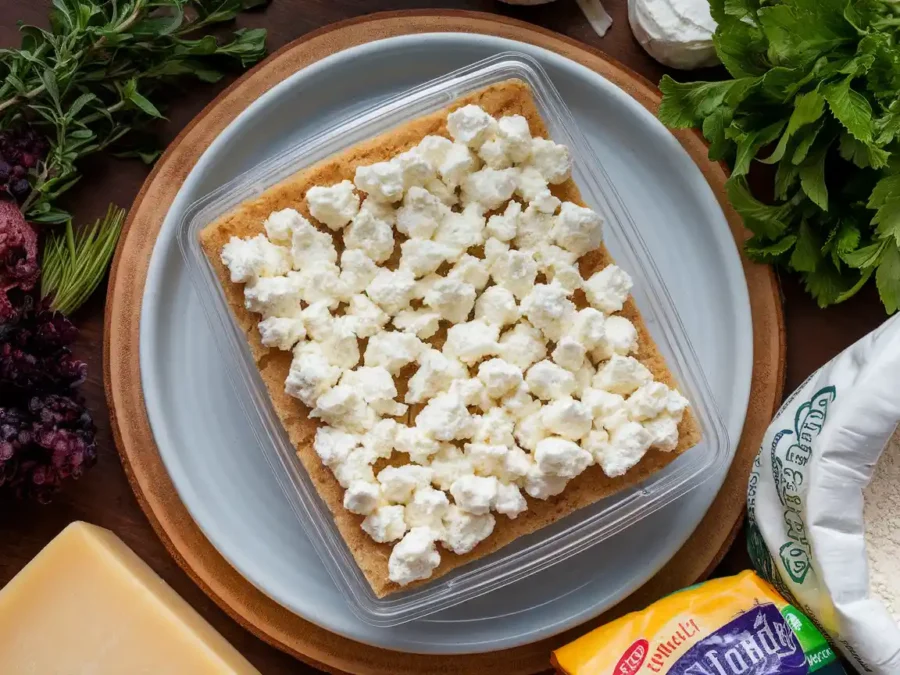Cottage cheese flatbread is a versatile and delicious dish, loved for its high-protein content and adaptability. Whether you’ve whipped up a batch for meal prep or have leftovers from dinner, you might wonder, “How long does the cottage cheese flatbread last?” In this article, we’ll explore the factors that impact its shelf life, proper storage methods, and reheating tips to keep it fresh and tasty. Let’s dive in and ensure your flatbread always stays at its best!
Table of Contents
Understanding the Shelf Life of Cottage Cheese Flatbread
Knowing how long cottage cheese flatbread lasts starts with understanding its ingredients and how they affect freshness. Let’s break it down.
How Long Can Cottage Cheese Flatbread Be Stored?
Generally, cottage cheese flatbread can last up to 3-5 days in the refrigerator when stored in an airtight container. The exact duration depends on factors like how fresh the ingredients were when you made it and the conditions of your fridge.
For longer storage, you can freeze it, which preserves its quality for up to a month. This makes it a great option for meal prep or bulk baking days. However, freezing may slightly alter the texture, so proper reheating is crucial for restoring its original consistency.
Factors Affecting the Shelf Life
Several factors can influence the shelf life of your flatbread. Here are the key ones to watch out for:
- Moisture Content: The natural moisture in cottage cheese can make flatbread more perishable than drier alternatives. Always drain the cottage cheese well before using it to extend shelf life.
- Temperature Control: Proper refrigeration is essential. Storing flatbread at room temperature for too long can promote bacterial growth and spoilage.
- Toppings: Wet toppings, like tomatoes or sauces, can reduce freshness, especially if they’re added before storing. Keep toppings separate and add them right before serving.
Understanding these factors helps you make informed decisions about when and how to enjoy your flatbread at its freshest.
Proper Storage Techniques for Cottage Cheese Flatbread
Storing cottage cheese flatbread correctly is essential to maintain its freshness and texture. The right methods ensure it lasts longer without losing flavor or quality.
Refrigerating Cottage Cheese Flatbread
Refrigeration is the most straightforward way to store flatbread and keep it fresh for several days. When asked, “How long does the cottage cheese flatbread last?”, refrigeration usually extends its shelf life to 3-5 days.
- Wrap It Well: Use plastic wrap, aluminum foil, or an airtight container to prevent the flatbread from drying out or absorbing other food odors in the fridge.
- Store It Without Toppings: If your flatbread has perishable toppings, like tomatoes or yogurt, store them separately to avoid sogginess.
- Position Matters: Place the container in the middle of the refrigerator where the temperature is stable, avoiding areas like the fridge door that experience frequent temperature changes.
By following these steps, you can enjoy freshly baked flatbread over several meals without sacrificing quality.
Freezing Cottage Cheese Flatbread for Extended Use
For those who want to prepare in bulk, freezing is an excellent option. Properly frozen flatbread can last up to a month.
- Pre-Freeze for Best Results: Before freezing, allow the flatbread to cool completely. Stack individual pieces with parchment paper between them to prevent sticking.
- Choose the Right Storage Bags: Use freezer-safe zip-top bags or airtight containers to protect against freezer burn.
- Label and Date: Always label your bags with the storage date to keep track of how long it has been in the freezer.
When it’s time to eat, reheat the flatbread directly from frozen using an oven or skillet for the best texture.

Tips for Reheating Cottage Cheese Flatbread
Reheating flatbread the right way ensures it remains soft and flavorful without becoming soggy or dry. Here’s how to do it perfectly.
Best Methods to Reheat Without Compromising Texture
Reheating can be tricky, especially when dealing with cottage cheese flatbread. To maintain its original texture, consider these methods:
- Oven Reheating: Preheat the oven to 350°F (175°C), wrap the flatbread in foil, and heat for about 5-10 minutes. This method preserves its moisture while ensuring it stays warm.
- Skillet Method: Heat a non-stick skillet over medium heat and place the flatbread on it. Cover the skillet with a lid to create a steaming effect, which keeps the bread soft.
- Toaster Oven: For a quicker option, use a toaster oven to reheat small pieces. This method is ideal for achieving a slightly crisp texture.
Each method brings out the best in your flatbread without altering its flavor or consistency.
Common Reheating Mistakes to Avoid
Avoid these pitfalls to ensure your reheated flatbread tastes as good as fresh:
- Skipping the Lid or Wrap: Heating flatbread without covering it can cause it to dry out. Always use foil, a lid, or parchment paper for moisture retention.
- Overheating: Excessive heat can harden or burn the flatbread. Stick to the recommended temperature and reheating times for the best results.
- Microwaving: While convenient, microwaving can lead to uneven heating and sogginess. If you must use a microwave, wrap the flatbread in a damp paper towel to minimize moisture loss.
Proper reheating ensures your cottage cheese flatbread stays just as delicious as when it was freshly baked.
Creative Uses for Leftover Cottage Cheese Flatbread

If you’ve ever wondered what to do with leftover cottage cheese flatbread, there’s good news this versatile dish can be transformed into exciting new meals. Let’s explore a few creative ways to breathe new life into your leftovers while addressing storage questions like “How long does the cottage cheese flatbread last?”.
Transforming Leftovers Into New Meals
Leftover flatbread is the perfect base for inventive dishes. By using what you already have, you can create something entirely different with minimal effort.
- Flatbread Pizza: Spread marinara sauce over your flatbread, top with shredded cheese, vegetables, or cooked meats, and bake in the oven until the cheese melts. It’s a quick, customizable meal the whole family will enjoy.
- Flatbread Wraps: Reheat the flatbread and fill it with your favorite proteins, fresh veggies, and sauces. Whether it’s grilled chicken or falafel, this idea works for lunch or dinner.
- Flatbread Chips: Cut the flatbread into small triangles, brush them with olive oil, sprinkle with spices, and bake until crisp. These chips pair wonderfully with hummus, salsa, or guacamole.
These ideas not only save leftovers but also add variety to your meals.
Pairing Flatbread With Complementary Dishes
Cottage cheese flatbread shines when paired with complementary sides and toppings. If you’re looking for ideas to enhance your dish, consider the following options:
- Soups and Stews: Pair warm flatbread with hearty soups like tomato bisque, lentil stew, or chicken noodle soup for a comforting combination.
- Breakfast Creations: Add scrambled eggs, avocado slices, and a sprinkle of cheese for a breakfast sandwich twist.
- Dips and Spreads: Serve the flatbread alongside baba ganoush, tzatziki, or creamy spinach dip for a delightful snack or appetizer.
For more culinary inspiration, check out TastySara’s collection of easy recipes, such as banana bread cookies, which also explore creative uses for leftovers.
Extending the Shelf Life of Cottage Cheese Flatbread
If you’re looking to maximize how long cottage cheese flatbread lasts, a few simple practices can help you extend its freshness. From preparation to storage, small changes can make a big difference.
Best Practices for Preparation
The way you prepare your flatbread significantly impacts how long it stays fresh. By making mindful adjustments during preparation, you can enjoy your flatbread for a longer time.
- Use High-Quality Ingredients: Fresh cottage cheese and high-quality flour are essential for maintaining the integrity of your flatbread. Stale or near-expired ingredients will reduce its shelf life.
- Drain Cottage Cheese: Always drain excess moisture from the cottage cheese before mixing it into the dough. This step prevents the flatbread from becoming soggy and spoiling too quickly.
- Cook Thoroughly: Ensure your flatbread is fully cooked before storing it. Undercooked dough may retain moisture, making it prone to spoilage.
Innovative Storage Solutions
While traditional storage methods work, innovative solutions can add an extra layer of convenience and longevity.
- Vacuum Sealing: Vacuum-sealing your flatbread removes excess air, slowing down the oxidation process. This is particularly useful for freezing flatbread for extended periods.
- Silicone Bags: Reusable silicone bags are an eco-friendly alternative to plastic and help maintain freshness. Ensure the bags are airtight to prevent moisture loss or contamination.
- Portion Control: If you’re freezing multiple flatbreads, divide them into single-serving portions. This way, you can reheat only what you need without exposing the rest to temperature changes.
Common Mistakes to Avoid
While storing and reheating cottage cheese flatbread may seem straightforward, there are common mistakes that can impact its quality. Avoiding these pitfalls ensures you always enjoy the best version of your flatbread.
Mistake 1: Storing While Hot
One of the most common errors is storing flatbread before it has cooled completely. Heat creates condensation inside storage containers, which can lead to sogginess and shorten the flatbread’s lifespan.
- Solution: Let your flatbread cool on a wire rack before sealing it in an airtight container or freezer bag. This allows any residual steam to escape, preventing moisture buildup.
Mistake 2: Using the Wrong Storage Materials
The materials you use to store your flatbread matter. Thin plastic wrap or loosely sealed bags can allow air and odors to seep in, affecting freshness and flavor.
- Solution: Opt for sturdy, airtight containers or resealable silicone bags that provide a proper seal.
Mistake 3: Overloading the Refrigerator or Freezer
Overcrowding your fridge or freezer can impact airflow, which is crucial for maintaining consistent temperatures. This inconsistency can lead to uneven storage conditions, causing spoilage in some areas.
- Solution: Organize your storage space to allow air circulation, and place flatbread in a central location for optimal cooling.
By addressing these common mistakes, you’ll not only improve the shelf life of your flatbread but also enjoy its texture and flavor every time you reheat it.
Comparing Shelf Life with Other Homemade Flatbreads
When considering how long does the cottage cheese flatbread last?, it’s helpful to compare its shelf life with other types of flatbreads. Different ingredients and preparation methods influence how long each variety remains fresh.
Cottage Cheese Flatbread vs. Traditional Flatbreads
Cottage cheese flatbread typically has a shorter shelf life compared to traditional flatbreads like naan or pita. The high moisture content in cottage cheese accelerates spoilage, especially if not stored correctly.
- Moisture Impact: Traditional flatbreads, made with minimal dairy or wet ingredients, tend to last 5-7 days in the fridge, while cottage cheese flatbread lasts about 3-5 days under similar conditions.
- Storage Adjustments: While both can be frozen, cottage cheese flatbread benefits more from vacuum sealing or portioning to maintain its quality during extended storage.
Cottage Cheese Flatbread vs. Gluten-Free Options
Gluten-free flatbreads often rely on ingredients like almond flour or coconut flour, which naturally extend shelf life due to their lower moisture content.
- Texture Over Time: Gluten-free flatbreads maintain their texture longer in refrigeration compared to cottage cheese flatbread, which may become soggy if not stored properly.
- Reheating Needs: Both types require careful reheating, but gluten-free options are less prone to drying out.
Understanding these comparisons can help you decide how to plan your meals and storage based on the type of flatbread you’re making.
Final Tips for Maximizing Shelf Life
As we wrap up, let’s focus on actionable tips that ensure your cottage cheese flatbread remains fresh and delicious for as long as possible.
Incorporating Fresh Ingredients Only
The freshness of your ingredients directly impacts how long your flatbread lasts. Using fresh cottage cheese, recently milled flour, and high-quality oils prevents early spoilage.
- Check Expiry Dates: Always check the expiration dates of your ingredients before using them. Ingredients nearing their expiry can shorten the overall shelf life of the flatbread.
- Proper Handling: Avoid cross-contamination by using clean utensils and a sanitized workspace during preparation.
Plan for Leftovers
If you’re making flatbread for meal prep or a gathering, planning how to handle leftovers can save you time and waste.
- Pre-Portion Before Freezing: Cut the flatbread into meal-sized portions and freeze them individually. This makes reheating easier and reduces exposure to moisture during storage.
- Create Versatile Meals: Use your leftovers creatively flatbread pizzas, wraps, or chips to keep meals exciting while extending usage.
These strategies not only help you make the most of your flatbread but also ensure it remains safe and enjoyable for days.
FAQs About Cottage Cheese Flatbread
When exploring the question, “How long does the cottage cheese flatbread last?”, related concerns about preparation, storage, and usage often come up. Here are some common FAQs to guide you.
Why Is My Cottage Cheese Flatbread Soggy?
Soggy flatbread is typically the result of too much moisture in the dough or improper storage. Draining the cottage cheese before mixing and using airtight containers for storage can help. Additionally, reheating with the proper method ensures your flatbread stays crisp.
Does Cottage Cheese Melt Like Cheese?
Cottage cheese doesn’t melt in the same way as traditional cheeses like mozzarella. Instead, it softens and blends, providing a creamy texture. This characteristic is ideal for flatbread dough but might require modifications if used as a topping.
Why Is Cottage Cheese Not Keto?
While cottage cheese is generally low in carbs, some brands contain added sugars or fillers that increase the carb count. To keep it keto-friendly, select plain, full-fat cottage cheese with minimal ingredients.
Can the Batter Be Stored Before Cooking?
Yes, you can store flatbread batter in the refrigerator for up to 24 hours. Ensure it’s in an airtight container to prevent it from drying out or absorbing other odors. Bring the batter to room temperature before cooking for the best results.

